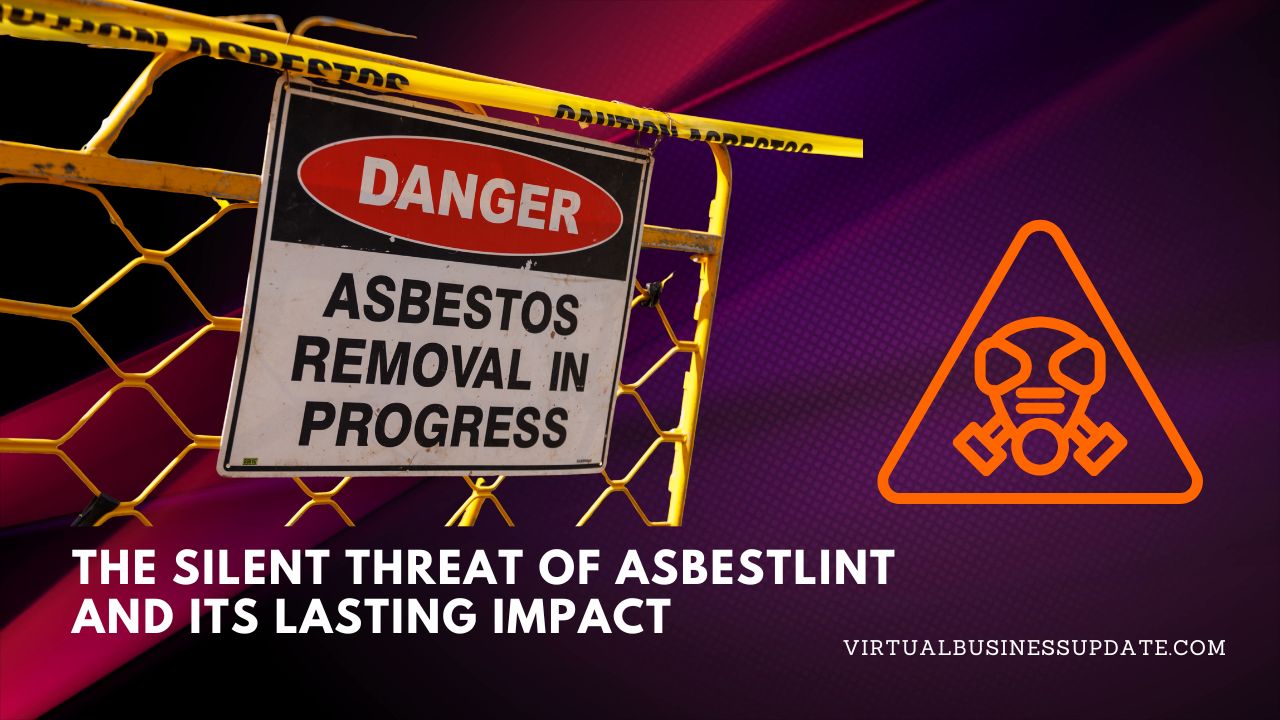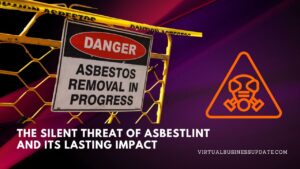Asbestlint hides in old walls, floors and forgotten corners. It looks harmless, but danger lies beneath its dusty surface. This silent threat can harm lungs and weaken human health. Many homes and buildings still carry this hidden toxic risk.
Breathing in its fine fibers can scar lungs and steal breath. People often ignore it, but ignoring it never makes it safe. Asbestlint exposure links directly to severe diseases like lung cancer. Families unknowingly live with danger woven into their daily spaces.
The true risk appears slowly, often decades after first exposure. Workers renovating old sites face the greatest hidden daily danger. Protective steps and awareness can shield lives from this threat.
Testing and safe removal bring peace of mind and health. Communities must act now before another life pays the price. Asbestlint is not just dust it is a ticking time bomb. Awareness today saves futures tomorrow from its silent deadly grip.
What is asbestlint and where is it usually found?
Definition and basic understanding of asbestlint
Asbestlint is a harmful material often hidden in old structures. It may look safe, but it carries serious health risks. People once used it widely because it was cheap and strong. Builders mixed it into walls, tiles and even insulation.
Today, experts know it releases fibers that damage the lungs. Breathing these fibers over time can cause lasting respiratory illness. It is invisible, making the danger even harder to detect. Many older homes and schools still have it inside walls.
Children and workers are most at risk when repairs begin. Without proper safety steps, tiny fibers can spread in the air. Removing it requires skill, training and special protective equipment. Governments now warn about its dangers and restrict its use. Yet, its presence still lingers in countless older places. Understanding asbestlint is the first step toward safety and protection.
Common places where asbestlint is hidden
Old buildings often hide dangerous materials inside their walls and floors. Asbestlint is one such material often overlooked by many people. It can be tucked into ceilings, tiles and heating ducts. Many homes built before 1980 still carry this hidden risk.
Schools and offices may also contain it in their infrastructure. Renovation projects often disturb the dust and spread toxic fibers. Even simple repairs can release dangerous particles into the breathing air. Most families remain unaware until inspections reveal the hidden threat.
Roof shingles, floor tiles and insulation often contain these fibers. Workers in demolition face danger daily when removing old structures. The substance hides quietly, showing no visible signs to the eye.
Professional testing is the only sure way to confirm presence. Once found, experts can safely remove it from the space. Knowing where asbestlint hides helps prevent exposure and saves countless lives.
Why is asbestlint considered a serious health hazard today?
The toxic nature of asbestlint fibers
The danger of hidden fibers comes from their toxic structure. Once disturbed, they float in the air and enter human lungs. Asbestlint may seem harmless, but inside, it carries poison. The fibers are sharp and cling tightly to lung tissue.
Over time, they cause scarring and reduce breathing ability. Exposure is dangerous because damage often happens silently and slowly. Most people never notice symptoms until many years have passed. The body cannot break down these harmful fibers naturally.
This makes the damage permanent and often irreversible for patients. The toxic power explains why governments banned its new use. Yet, old homes and buildings still contain this deadly threat.
Every repair or demolition increases the risk of exposure. Knowing the toxic nature helps people respect the danger seriously. Asbestlint is not dust it is poison hiding in plain sight.
Long-term dangers linked with daily exposure
Health risks from hidden fibers grow worse with daily exposure. Asbestlint shows its effects slowly, sometimes after 10 to 40 years. People may feel healthy but face risks building over time. Regular inhalation causes the lungs to harden and lose strength.
Shortness of breath, coughing and chest pain become common signs later. Some victims even face mesothelioma, a rare and deadly cancer. Doctors link this disease directly to asbestos-based fibers in the air.
Workers in renovation or demolition face the highest daily exposure. Families can also face danger from dust brought home. The long wait before illness makes prevention even more urgent. Without awareness, entire generations can suffer without early warning signs.
Protecting air quality is vital when old structures are disturbed. Each breath matters and every particle increases the threat. Long-term danger proves why asbestlint deserves serious attention from every community.
How does exposure to asbestlint affect human lungs and health?
Respiratory problems caused by inhaling fibers
When people inhale toxic fibers, the lungs face serious harm. Asbestlint fibers are sharp, making them dangerous to soft tissues. Once inside, they irritate and cause scarring on the lungs. This scarring reduces oxygen flow and weakens overall breathing ability.
Over the years, even mild exposure can lead to lasting problems. Symptoms often include coughing, wheezing and painful chest tightness. Asthma-like issues can appear, even in those without a history.
The condition known as asbestosis is common after repeated exposure. Victims often need regular medical care and breathing support devices. What makes this worse is the delay in visible symptoms.
By the time issues appear, the lungs are already damaged. This damage is permanent and makes life more difficult daily. Protecting the lungs means avoiding exposure as much as possible. Once inhaled, asbestlint can cause lifelong respiratory struggles for its victims.
Connection to chronic illnesses and cancers
Long exposure to harmful fibers does more than scar lungs. Asbestlint also creates conditions that can lead to deadly illnesses. One of the most dangerous outcomes is lung cancer. The fibers irritate cells and trigger uncontrolled cancer growth.
Mesothelioma, a rare cancer, is almost always linked to exposure. It attacks the lining of lungs and other internal organs. Symptoms show very late, making treatment harder for patients. Victims often discover illness when it has already spread widely.
Families can suffer because of exposure brought from workplaces. Even small fibers on clothes can reach loved ones at home. Medical costs and emotional toll make this a heavy burden. Prevention is the only real cure for these risks.
Avoiding exposure is the strongest protection against long-term chronic disease. The link between cancer and asbestos should never be ignored or dismissed.
Who faces the highest risk of contact with asbestlint?
Workers in construction and renovation fields
Construction and renovation workers face direct daily exposure to hidden dangers. Asbestlint is often disturbed when old materials are cut or removed. These workers breathe in fibers while fixing homes and buildings. Demolition projects are especially risky because dust spreads quickly.
Without masks or protective suits, fibers enter lungs easily. Even short projects can expose workers to dangerous levels. Many workers remain unaware until health problems appear years later. Regulations now demand protective gear in high-risk job sites.
Training programs also teach safe handling and removal techniques. Employers must provide safety tools to reduce risk on jobs. Ignoring rules can cost workers their long-term health and safety.
Every project involving older structures should include a risk assessment. Workers who protect themselves today save their health tomorrow. Asbestlint remains one of the biggest threats for construction and renovation staff.
Families living in older homes and buildings
Families in old homes often live with danger without knowing. Asbestlint can hide quietly inside walls, ceilings and old floors. Children breathe more deeply, making them especially vulnerable to harm. Parents may only notice when a home repair stirs dust.
Every day living can become risky without proper inspection and awareness. Small cracks or damage in old tiles can release fibers. Even heating systems may carry dust through the entire house. Families deserve safe air but face risks hidden in their homes.
Simple activities like cleaning can unknowingly disturb harmful particles. Professional inspections give families peace of mind and safety. Once detected, trained experts can remove the material safely.
Homeowners should always test before starting renovation or repair work. Protecting families means preventing exposure before damage takes place. Old homes may carry memories, but asbestlint can carry deadly risks.
What safety measures can prevent harm from asbestlint exposure?
Protective equipment and workplace safety rules
Strong protective equipment helps reduce exposure in dangerous work environments. Asbestlint spreads easily when workers disturb old building materials. Masks with filters stop harmful fibers from entering the lungs.
Gloves, suits and goggles protect skin and eyes from contact. Safety rules require sealed areas during removal or demolition work. Warning signs must alert people about high-risk spaces nearby.
Workers should never eat, drink, or smoke in areas where dust is present. Regular training helps workers understand risks and follow safety steps. Employers must provide protective gear and enforce safety guidelines on a daily basis. Proper disposal prevents fibers from spreading into community spaces.
Ventilation systems should be sealed to keep air clean. Families should avoid entering work areas during dangerous projects. These measures lower risks but require strict discipline to succeed. With strong rules, workers can avoid harm from asbestlint exposure daily.
Awareness programs for homes and communities
Community awareness plays a big role in reducing hidden danger. Asbestlint is often ignored because people do not understand risks. Education programs explain where it hides and why it is deadly. Schools can teach children the importance of safe environments.
Workshops guide homeowners on safe renovation and testing practices. Local health groups should spread information through campaigns and events. Online resources also help families learn safety tips at home.
When people know risks, they act faster to protect themselves. Neighbors can share advice and encourage inspections for older houses. Governments can support communities with free or low-cost testing. Awareness builds a culture of safety and collective responsibility.
Together, people can prevent exposure before it harms more families. Informed citizens make healthier choices for themselves and loved ones. Awareness programs remain key tools in protecting lives from asbestlint dangers.
How can homes and buildings be tested and cleared of asbestlint?
Professional testing and inspection methods
Testing is the only way to confirm dangerous materials inside. Asbestlint cannot be seen with the naked human eye. Professionals use special tools to take air and material samples. These samples are checked in labs for dangerous fibers.
Certified inspectors understand where to look for hidden risks. They focus on walls, floors, ceilings and heating systems. Homeowners should never attempt testing alone without proper safety gear. Disturbing materials without training can release fibers into the air.
Professional testing ensures accurate results and safe handling of materials. Reports from inspections guide families on the next safe steps. Testing is quick, efficient and worth the peace of mind.
It prevents unnecessary risks during repairs or renovations at home. Knowing the results gives families the power to act wisely. Professional testing remains the safest first step in handling asbestlint.
Safe removal and long-term prevention solutions
Once detected, dangerous materials must be removed safely and carefully. Asbestlint removal is a task only experts should handle. Trained teams use sealed rooms and advanced protective equipment. They wet materials to reduce dust before cutting or removal.
Special containers hold waste so fibers do not spread outside. Workers transport waste to approved sites for safe disposal. Families should never stay in their homes during removal projects.
Long-term prevention means regular inspections of older buildings and houses. Sealing or covering certain materials can also reduce exposure risks. New building codes ban the use of harmful asbestos-based materials.
Awareness and prevention programs further reduce risks for communities. Removing the threat ensures cleaner air and healthier living spaces. Prevention today means fewer health problems for future generations. Safe removal is the final shield against dangers of asbestlint.
Frequently Asked Questions:
What is asbestlint?
Asbestlint is a harmful material found in older buildings. It releases tiny fibers when disturbed. These fibers can enter the lungs, cause scarring and lead to serious long-term health issues.
Where is asbestlint usually found?
Asbestlint often hides in walls, ceilings, floors and insulation. Many buildings built before 1980 contain it. Renovation or demolition activities usually disturb it, releasing toxic particles into the air.
Why is asbestlint dangerous?
Asbestlint is dangerous because its fibers damage lung tissue permanently. Inhaling these fibers can cause asbestosis, lung cancer and mesothelioma. The symptoms often appear decades after initial exposure.
How can I know if my home has asbestlint?
Only professional testing can confirm asbestos in a building. Inspectors take samples from walls, tiles, or insulation. Lab results provide accurate detection, helping families decide on removal or management.
How can asbestlint be removed safely?
Asbestlint should always be removed by trained professionals. They use protective equipment, sealed areas and proper disposal methods. Families should avoid DIY removal, as it increases exposure and health risks.
Conclusion:
Asbestlint remains one of the most serious hidden home dangers. Many families live unaware of the threat resting inside older buildings. The fibers are invisible but cause lasting harm to lungs. Simple repairs can release particles and spread them into the air.
Workers and families face equal risks when safety steps are ignored. Testing and professional removal provide the strongest protection against exposure. Communities must spread awareness to help protect future generations from danger.
Prevention today means fewer health problems tomorrow and safer homes overall. Asbestlint should never be underestimated because its effects last a lifetime. Awareness truly saves lives.








